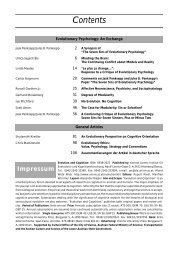Contents - Konrad Lorenz Institute
Contents - Konrad Lorenz Institute
Contents - Konrad Lorenz Institute
You also want an ePaper? Increase the reach of your titles
YUMPU automatically turns print PDFs into web optimized ePapers that Google loves.
Michel A. Hofman<br />
Biological Limits to<br />
Information Processing<br />
If the ability of an organism to process information<br />
about its environment is the driving force behind<br />
evolution, then the more information a system,<br />
such as the brain, receives, and the faster it can process<br />
this information, the more adequately it will be<br />
able to respond to environmental challenges and<br />
the better will be its chances of survival. The limit to<br />
any intelligent system therefore lies in its abilities to<br />
process and integrate large amounts of sensory information<br />
and to compare these signals with as<br />
many memory states as possible, and all that in a<br />
minimum of time. It implies that the functional capacity<br />
of a neural structure is inherently limited by<br />
its cellular architecture and signal processing time.<br />
In other words, there are design principles and operational<br />
modes that constrain the potential size and<br />
processing power of the brain (see, e.g., HOFMAN<br />
2001b; LAUGHLIN/SEJNOWSKI 2003).<br />
Although the details of the interpretation of the<br />
columnar organization of the cortex are still controversial,<br />
it is evident that the cerebral cortex is characterized<br />
by the hierarchical organization of groups<br />
of neurons. To group neurons into functional units<br />
interacting over relatively short distances allows<br />
these groups to inform as many adjacent clusters of<br />
neurons about the state of the ‘emitting’ cluster<br />
with as little as possible redundancy of information.<br />
Generally, the growth of connections to units is a<br />
factorial function of the number of units in a fully<br />
connected network and a linear function of the<br />
number of units in a minimally connected network<br />
(DEACON 1990; RINGO 1991). Once the brain has<br />
grown to a point where the bulk of its mass is in the<br />
form of connections, then further increases will be<br />
unproductive, due to the declining capability of<br />
neuronal integration and increased conduction<br />
time. At this point, corresponding to a brain size<br />
two to three times that of modern man, the brain<br />
reaches its maximal processing power (HOFMAN<br />
2001b). The larger the brain grows beyond this critical<br />
size, the less efficient it will become.<br />
Recently, COCHRANE and his colleagues (1998)<br />
looked at the different ways in which the brain<br />
could evolve to process more information or work<br />
more efficiently. They argue that the human brain<br />
has (almost) reached the limits of information processing<br />
that a neuron-based system allows and that<br />
our evolutionary potential is constrained by the delicate<br />
balance maintained between conduction<br />
speed, pulse width, synaptic processing time, and<br />
neuron density. By modeling the information processing<br />
capability per unit time of a human-type<br />
brain as a function of interconnectivity and axonal<br />
conduction speed they found that the human brain<br />
lies about 20–30% below the optimal, with the optimal<br />
processing ability corresponding to a brain<br />
about twice the current volume. Any further enhancement<br />
of human brain power would require a<br />
simultaneous improvement of neural organization,<br />
signal processing and thermodynamics. Such a scenario,<br />
however, is an unrealistic biological option<br />
and must be discarded because of the trade-off that<br />
exists between these factors. So it seems that within<br />
the limits of the existing ‘Bauplan’ there is no incremental<br />
improvement path available to the human<br />
brain.<br />
The Problem of Consciousness<br />
The explanation of consciousness is one of the major<br />
unsolved problems of modern neuroscience. After<br />
several thousand years of speculation, there is at<br />
the moment still no agreed answer to the problem<br />
of consciousness in explaining how organisms produce<br />
representational models of the world, except<br />
that most philosophers and neuroscientists do not<br />
believe in an immaterial mind which is distinct<br />
from the brain. Indeed, it is probable that at any<br />
moment some neural processes in the brain correlate<br />
with consciousness, while others do not.<br />
Although everyone has a notion of what is meant<br />
by being conscious, any attempt at a formal definition<br />
of consiousness, however, is likely to be either<br />
misleading or overly restrictive. In fact, there are<br />
many forms of consciousness, such as those associated<br />
with seeing, thinking, pain, emotion and so<br />
on. It is plausible that some organisms—in particular<br />
the higher encephalized mammals with their<br />
complex nervous systems—possess some of the essential<br />
features of consciousness, but not necessarily<br />
all. It follows that a language system—of the type<br />
found in humans—is not essential for consciousness.<br />
This is not to say that language does not enrich<br />
consciousness considerably, as we shall see later.<br />
One might even argue about whether organisms<br />
with simple nervous systems, such as insects and<br />
molluscs, are not merely cellular reflex automata,<br />
but are conscious creatures, who are aware of the external<br />
world.<br />
From this perspective, consciousness and affective<br />
experience may have arisen concurrently in the<br />
evolution of the nervous system; as a way to elaborate<br />
and extend the potential reach of instinctual<br />
Evolution and Cognition ❘ 182 ❘ 2003, Vol. 9, No. 2








